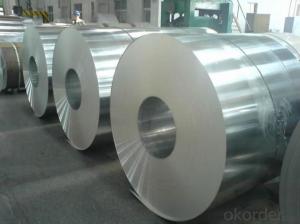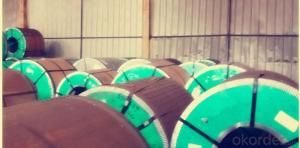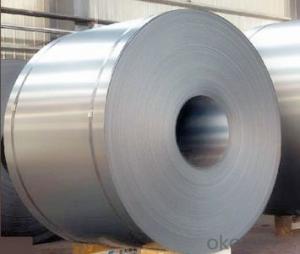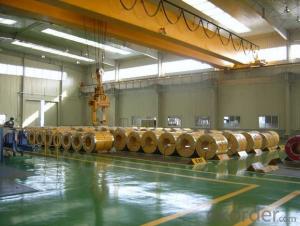Stainless Steel Coil 304 Hot Rolled Wide / Narrow No.1 Surface Finish
- Loading Port:
- Guangzhou
- Payment Terms:
- TT OR LC
- Min Order Qty:
- 100 m.t.
- Supply Capability:
- 8000 m.t./month
OKorder Service Pledge
OKorder Financial Service
You Might Also Like
Grade: | 300 Series | Standard: | JIS,AISI,ASTM,GB,DIN,EN etc | Thickness: | 2.5mm, 3.0mm, 4.0mm |
Width: | 550mm-1500mm | Length: | according to weight | Place of Origin: | China (Mainland) |
Brand Name: | CNBM | Model Number: | 304 | Technique: | Hot Rolled |
Application: | industry, construction, furniture, repairing | Certification: | MTC | Finishing: | NO.1 |
Market: | globle area | Packaged: | wooden and bags in cases as standard | Payment: | TT & LC |
Delivery time: | 15 days | MOQ: | 100 tons | Advantage: | prime quality, competitive price |
Profession: | hot rolled | Charactor: | stainless steel coils | Material/Grade: | 304 |
Hot Rolled Stainless Steel Coil 304 Annealing and Pickling No.1 Finish
Stainless steel is a production which not easy rust,acid resistance and corrosion resistance,so it is widely
used in light industry,heavy industry,daily necessities and the decoration industry.
Hot Rolled Stainless Steel Coil 304 Specifications
1.surface:NO.1
2.standard:JIS, AISI, GB
3.width: 0.55m, 0.65m, 1.0m, 1.22m, 1.5m, 2m or requirement
Hot Rolled Stainless Steel Coil 304 Chemical Composition:
(%):C=0.07, Mn=2.00, P=0.045, S=0.030, Si=0.075, Cr=17.5-19.5, Ni=8.0-10.5, N=0.10
Hot Rolled Stainless Steel Coil 304 Physical Properties
Tensile strength σb (MPa) ≥ 520
the conditions yield strength σ0.2 (MPa) ≥ 205,
elongation δ5 (%) ≥ 40
Reduction of ψ (%) ≥ 50,
hardness: ≤ 187
HB; ≤ 90
HRB; ≤ 200H
- Q: What is the machinability of stainless steel strips?
- The machinability of stainless steel strips can vary depending on the specific grade and hardness of the material. In general, stainless steel strips exhibit good machinability in comparison to other types of steel, thanks to their higher chromium content, which enhances their corrosion and heat resistance. However, stainless steel strips pose more difficulties in machining compared to carbon steel, given their greater strength and tendency to work harden. To achieve the desired machining results, it is crucial to exercise special care and employ appropriate cutting tools and techniques. Furthermore, factors such as the presence of other alloying elements, surface finish, and cutting conditions may also influence the machinability of stainless steel strips.
- Q: How do you prevent intergranular corrosion of stainless steel strips?
- To prevent intergranular corrosion of stainless steel strips, several measures can be taken. One of the most effective ways is to use stainless steel that has been properly heat treated and solution annealed, as this helps to eliminate carbide precipitation at grain boundaries. Additionally, utilizing low carbon grades of stainless steel can also reduce the susceptibility to intergranular corrosion. Another crucial step is to ensure proper cleaning and passivation of the stainless steel strips, which removes contaminants and promotes the formation of a protective oxide layer on the surface. Regular inspection and maintenance, such as avoiding exposure to aggressive environments and promptly repairing any damages or defects, can further help in preventing intergranular corrosion.
- Q: Are stainless steel strips suitable for cryogenic applications?
- Yes, stainless steel strips are suitable for cryogenic applications. Stainless steel has excellent mechanical properties and can withstand extremely low temperatures without losing its strength and durability. It also has good resistance to corrosion, making it a reliable choice for cryogenic environments.
- Q: Can stainless steel strips be used in the mining industry?
- Yes, stainless steel strips can be used in the mining industry. Stainless steel is known for its corrosion resistance and durability, making it suitable for various applications in the mining industry, such as conveyor systems, equipment components, and structural support. Its high strength and resistance to wear, heat, and chemicals make stainless steel strips a reliable choice for mining operations.
- Q: What are the mechanical properties of stainless steel strips?
- The mechanical properties of stainless steel strips include high tensile strength, good formability, excellent corrosion resistance, and durability. Additionally, stainless steel strips often exhibit low magnetic permeability, high fatigue strength, and good impact resistance, making them suitable for a wide range of applications in various industries.
- Q: Are stainless steel strips suitable for outdoor applications?
- Yes, stainless steel strips are suitable for outdoor applications. Stainless steel is highly resistant to corrosion, making it ideal for use in outdoor environments where it may be exposed to moisture, sunlight, and other weather conditions. Additionally, stainless steel has a high strength-to-weight ratio and excellent durability, ensuring long-lasting performance even in harsh outdoor settings.
- Q: What are the mechanical properties of 111 stainless steel strips?
- The mechanical properties of 111 stainless steel strips may differ based on factors like the manufacturing process and specific alloy composition. However, in general, stainless steel strips designated as 111 exhibit several crucial mechanical properties. 1. Tensile Strength: Typically, 111 stainless steel strips possess a high tensile strength, indicating their ability to withstand maximum tensile stress before failure. This quality makes them suitable for applications that require strength and resistance to deformation. 2. Yield Strength: The yield strength of 111 stainless steel strips signifies the stress at which the material permanently deforms. It is a critical property for determining the material's resistance to deformation under load. 3. Hardness: Often, stainless steel strips labeled as 111 have a high level of hardness, which measures their resistance to scratching, indentation, or penetration. This characteristic contributes to their durability and wear resistance. 4. Ductility: Ductility refers to a material's capacity to deform under tensile stress without breaking or fracturing. Although stainless steel generally possesses lower ductility compared to other metals, the specific ductility of 111 stainless steel strips can vary based on factors like alloy composition and processing method. 5. Corrosion Resistance: Stainless steel, including 111 stainless steel strips, is renowned for its exceptional resistance to corrosion. This property arises from the presence of chromium in the alloy, which forms a protective oxide layer that safeguards the material against rust and corrosion in diverse environments. It is important to recognize that these mechanical properties can slightly vary depending on the specific alloy composition, heat treatment, and manufacturing process employed in the production of 111 stainless steel strips. Therefore, referring to the manufacturer's specifications or conducting tests on the material is advisable to obtain precise mechanical property data for a particular application.
- Q: Are stainless steel strips resistant to fire?
- Yes, stainless steel strips are highly resistant to fire. Stainless steel is known for its exceptional heat resistance properties. It has a high melting point, which means it can withstand high temperatures without losing its structural integrity. Stainless steel strips also have a low thermal conductivity, meaning they do not conduct heat well, making them more resistant to fire. Additionally, stainless steel contains chromium, which forms a protective oxide layer on its surface when exposed to heat. This oxide layer acts as a barrier, preventing oxygen from reaching the steel and further enhancing its fire resistance. As a result, stainless steel strips are widely used in various applications where fire resistance is a critical requirement, such as construction, automotive, and aerospace industries.
- Q: What are the common weight tolerances for stainless steel strips?
- The common weight tolerances for stainless steel strips vary depending on the specific grade and thickness of the material. However, in general, stainless steel strips typically have weight tolerances ranging from +/- 5% to +/- 10%. This means that the actual weight of the strip may deviate by up to 5% or 10% from the specified weight. These tolerances are necessary due to the inherent variability in the manufacturing process and the possibility of slight variations in the thickness and density of the stainless steel. It is important to note that more precise weight tolerances may be achievable for custom-made or specialized stainless steel strips, depending on the manufacturer's capabilities and the customer's requirements.
- Q: Are stainless steel strips resistant to sulfuric acid?
- Generally, stainless steel strips exhibit resistance to sulfuric acid. This material is renowned for its corrosion-resistant nature and can withstand various chemicals, such as sulfuric acid, due to its high resistance. Nevertheless, the level of resistance may differ depending on the grade and composition of the stainless steel. When exposed to highly concentrated and hot sulfuric acid solutions, certain types of stainless steel may encounter limited corrosion. To ensure the appropriateness of stainless steel strips for a particular sulfuric acid application, it is advisable to seek guidance from a materials specialist or consult specific corrosion resistance charts.
Send your message to us
Stainless Steel Coil 304 Hot Rolled Wide / Narrow No.1 Surface Finish
- Loading Port:
- Guangzhou
- Payment Terms:
- TT OR LC
- Min Order Qty:
- 100 m.t.
- Supply Capability:
- 8000 m.t./month
OKorder Service Pledge
OKorder Financial Service
Similar products
Hot products
Hot Searches
Related keywords





























